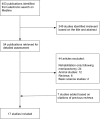Rehabilitation following meniscal repair: a systematic review
- PMID: 29682310
- PMCID: PMC5905745
- DOI: 10.1136/bmjsem-2016-000212
Rehabilitation following meniscal repair: a systematic review
Abstract
Objective: To review existing biomechanical and clinical evidence regarding postoperative weight-bearing and range of motion restrictions for patients following meniscal repair surgery.
Methods and data sources: Following the Preferred Reporting Items for Systematic Reviews and Meta-Analyses guideline, we searched MEDLINE using following search strategy: (((("Weight-Bearing/physiology"[Mesh]) OR "Range of Motion, Articular"[Mesh]) OR "Rehabilitation"[Mesh])) AND ("Menisci, Tibial"[Mesh]). Additional articles were derived from previous reviews. Eligible studies were published in English and reported a rehabilitation protocol following meniscal repair on human. We summarised rehabilitation protocols and patients' outcome among original studies.
Results: Seventeen clinical studies were included in this systematic review. There was wide variation in rehabilitation protocols among clinical studies. Biomechanical evidence from small cadaveric studies suggests that higher degrees of knee flexion and weight-bearing may be safe following meniscal repair and may not compromise the repair. An accelerated protocol with immediate weight-bearing at tolerance and early motion to non-weight-bearing with immobilising up to 6 weeks postoperatively is reported. Accelerated rehabilitation protocols are not associated with higher failure rates following meniscal repair.
Conclusions: There is a lack of consensus regarding the optimal postoperative protocol following meniscal repair. Small clinical studies support rehabilitation protocols that allow early motion. Additional studies are needed to better clarify the interplay between tear type, repair method and optimal rehabilitation protocol.
Keywords: arthroscopy; knee injuries; knee surgery; rehabilitation; sporting injuries.
Conflict of interest statement
Competing interests: None declared.
Figures








References
LinkOut - more resources
Full Text Sources
Other Literature Sources
